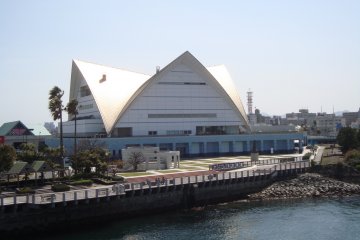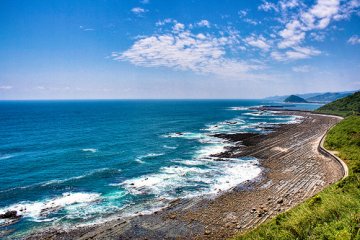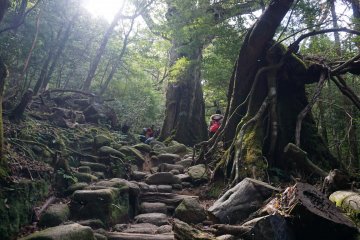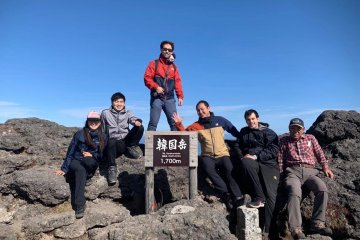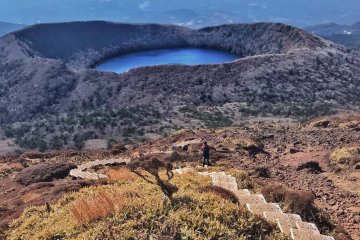A few months ago, I had the chance to join a 5-day trip to some of the most exciting destinations in Kagoshima Prefecture in the southern part of Japan. Here's a log of my journey as I visit Kirishima-Kinkowan National Park, a park characterized by the active volcano of Sakurajima and its surrounding caldera today filled with water and known as Kinko Bay. The second leg of my trip is an exploration of the idyllic forests of the island of Yakushima, part of the Osumi Islands and an established national park.
Day 1: The active volcano of Sakurajima

It is one of those early mornings when the alarm is set for when the sun has not yet shown itself. But it is also one of those mornings where you cannot wait for the alarm to sound since it will signal the start of a trip to some of the most impressive national parks in all of Japan.
Less than a 2-hour flight from Tokyo and I find myself in the southernmost prefecture of Japan (Okinawa excluded). The differences with the late autumn of Tokyo are deep - temperatures are higher, and there is a strong feeling of entering a totally different region. Not by chance was Kagoshima Prefecture once a completely separate domain; the Satsuma clan controlled this region and made it their stronghold until unification with the rest of Japan in 1871, a mere 150 years ago.
From Kagoshima Airport, a direct transfer by vehicle takes me to the volcanic island of Sakurajima. How did I get on an island by van? Well, it's now a peninsula. The last major eruption of 1914 filled the body of water between the island and the rest of Kagoshima with pyroclastic material. An alternative to driving is the convenient ferry from Kagoshima Port, providing the essential service of transporting people and vehicles, 24/7, every 15 minutes.
Sakurajima Volcano is the heart of the first National Park I get to visit. This beautiful ecosystem is entirely reliant upon geothermal activity and is home to the largest daikon radish in the world, as well as the smallest mikan Japanese mandarin, both with their official recognition in the Guinness Book of Records. The rich soil is also home to prosperous vegetation, which can be seen at different stages of growth depending on the area of Sakurajima you visit. Some areas of green might occasionally be covered in lava and ashes during the frequent eruptions, even if just under the form of an occasional puff from the summit.
Many are the attractions to be found on the peninsula. The ideal starting point is the Sakurajima Visitor Center, a few minutes’ walk from the ferry. Here, I got to meet a dedicated local guide who accompanied me across the island to observatories such as the Yunohira Observatory and the Arimura Lava Observatory. Each one showcases different perspectives and landscapes that have been shaped by the volcanic activity over recent centuries. The final visit is paid to a very symbolic Shinto shrine - three quarters of its torii gate has been buried under ash since the Taisho eruption of 1914. Today, this site is known as the Kurokami Buried Shrine Gate and is a testament for future generations to the power of the lord of this national park, Sakurajima Volcano.
After a heartfelt prayer at the shrine, it was time to bid farewell to Sakurajima National Park and head to Kirishima Onsen, an area known for its mineral-rich hot spring waters and the volcanic landscape of its national park. Once I checked-in at my first accommodation, I soaked myself in the natural hot spring of a rotenburo open-air bath while looking up at the clear, starry night sky. Feeling invigorated after the bath, I treated myself to a beautiful meal of traditional Japanese kaiseki ryori, an extraordinarily complex set of small dishes that use local specialties. Time to set another one of those happy alarms.
Day 2: Mount Karakuni's volcanic landscape

Another day, another immersive experience into the pristine nature of southern Japan. Today, I get to hike the Kirishima Long Trail, an approximately 6-hour hike that will take me through a land shaped by the energy of the earth. A local, experienced guide (he is 72 years old but hiked like a teenager) guided me through the very rugged landscape, up to the summit of Mount Karakuni, which sits at an altitude of 1700 meters. The almost lunar-like landscape is unspoiled; steam rises from some peaks while others have been less active. One of them - Omamino Ike, a huge crater filled with rain water - is my next destination.
On my way to this deep blue volcanic lake, I cannot stop thinking of how unique this area of Japan is and how it represents perhaps the most untamed side of the country. I'm reminded that the whole of Japan is made up of thousands of volcanic islands. The very same energy that I see here first-hand, is the energy that shaped the land... My stomach brings me back from daydreaming. It's almost time for lunch. I am lucky enough to have a prepared lunch waiting for me in a hut toward the end of the trail. Once my stomach is satiated it is time for the final stretch of the hike which will gradually brings us back to civilization.
Just over an hour later, and I find myself in the center of Kagoshima City where I will spend my second night. Kagoshima is the prefectural capital and a mid-sized city of some 600,000 people rich in history. It definitively deserves some time to visit and I do not lose the chance for an evening walk by its main river. Dinner is a local specialty called kuro kuma nabe. Literally meaning black bear stew, it's a hot pot made of vegetables, black pork, and black beef, both two popular local sources of meat. Other local Kagoshima delicacies are the shikuma white bear shaved ice cream, and the tori-sashi raw chicken. The latter is definitively not for the faint of heart.

Day 3: The nature of Yakushima and Shiratani Unsui Valley
After having experienced the beauty of two National Parks of the Kagoshima mainland, I head to the port to hop on the jet boat taking me to that most secretive and iconic of Kagoshima’s natural ecosystems, the island of Yakushima. About a 3-hour boat ride from the mainland, this famous island is known for its primeval cedar forests with some trees being over 1,000 years old. Abundant rainfalls bless the island throughout the year and allow the granite, of which the island is mostly made, to preserve a huge amount of freshwater. This freshwater provides all the nutrients for the huge yakusugi cedar trees of the island to thrive.
Back at the Miyanoura Pier, I am welcomed by my local guide for the three days I'll be on the island. He spent 10 years on this island and started his own hiking guide company with the support of his wife. His passion for nature is evident from the start and I quickly understand the reason he chose to move to this island all the way from New Zealand many years ago. There is something unique about Yakushima. It cannot be compared to anywhere else - not only in Japan but the world. When I told my friends that I would be visiting, I could see the look of astonishment on their faces. Yakushima holds a special place in the back of their minds as a spiritual and, almost, fantastical location.
My first day is spent hiking what is known as one of the most beautiful trails thanks to the abundant carpet of moss that grows without disturbance. The area I am referring to is the Shiratani Unsui Valley. This place was also a fount of inspiration for the famous animation movie Mononoke Hime (Princess Mononoke) by acclaimed director Hayao Miyazaki. It almost feels like some of the kodama forest spirits of Japanese folklore really could show up at anytime from behind a tree or from underneath a boulder. At the end of the hike, we are rewarded with a beautiful sunset over the sea, followed by a rich dinner. It’s time to rest for the next full day of hiking.
Day 4: Off the beaten track in Yakushima

An early rise and breakfast allow me to meet my guide and have a full tour of the island by car with several stops. The first stop is Ohkono Falls, one of the main waterfalls of Yakushima that slides sideways down a huge granite wall. After the brief photo stop, we reach the Yakushima Lighthouse, which offers a beautiful view over Tanegashima, a neighbouring island famous for its Space Center.
Next is the main hike for the day. Our expert guide takes us to one of the most secluded paths by the coast. I cannot ignore the differences from the trail I took the day before; the altitude and proximity to the sea really change the scenery to one more tropical. I soon discover that it is not just my imagination. The warmer temperatures allow trees like the banyan to prosper. These trees are widespread in Southeast Asia and are used as repair against typhoons in some countries; they are also known as the moving trees, as they stretch their roots out under the forest’s floor like huge, knotty feet.
However, it is at the center of this forest that we experience the most special of encounters. First, we spot a large male deer, the yakushika deers are slightly different from their mainland counterpart and are normally unafraid of humans. This one is no exception and lets us follow him until we reach a small valley. Among the ruins of a WWII military camp, we spot an entire family of Yakushima macaques in the company of some deer. It's rare to spot the two species together in their natural environment. I am left speechless by the beauty and the untouched scenery. Without disturbing them, we slowly diverge from our path in order to avoid walking straight through them. We re-emerge from the forest with the awareness of having witnessed something stunning.
The rest of the day is passed visiting local stores selling local goods. I get to try some of the local nihonshu (sake) and a whisky aged in caskets made of yakusugi wood. As a World Heritage Site and National Park, the forest is protected. However, until recently, some of these millenary trees were cut down to harvest high-quality wood. These wood stocks are used to create furniture and household goods sold at another of the stores I visit.
Day 5: A final glance at Yakushima

Time flies when you are having fun. The intense trip I set off on four days prior is coming to an end but not before spending a few more hours and activities on Yakushima.
The first activity is an unusual one, a stand-up paddleboard river experience done on a very calm river that flows directly into the sea. At first, it takes me a while to adjust to the board and I succeed after a couple of loud and awkward jumps in the water. During the ride, I see Yakushima from a different perspective while the way back is particularly present as I gently follow the current toward our starting point.
Yakusugi Land is the last hike of the trip and our last look at Yakushima’s nature. This park is relatively small and ideal for those interested in a half-day or shorter hike. It showcases some beautiful suspension bridges where you can enjoy the landscape from a higher point of view.
In the late afternoon, I sail back to the mainland, thanking my New Zealand guide for his essential guidance and the knowledge he offered during the past three days. Yakushima leaves me with a profound respect for nature, the complexity of ecosystems, and how important they are for all living beings. With these thoughts in mind, I enjoy the comfortable ride back to Kagoshima, from where I hop on a van directly to the airport.
A few check-ins and a couple of hours later and I am back in Tokyo. I write this with the feeling that I have just taken part in a very special trip, dense with experiences and in close communion with nature. The volcanoes, ancient forests, and mountaintops there gave me a deeper understanding of nature's complexity and importance.
Kagoshima Prefecture is a real gem.
And I cannot wait to go back.



